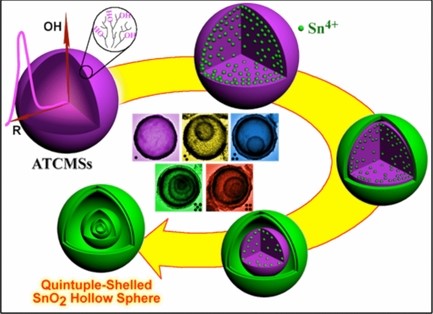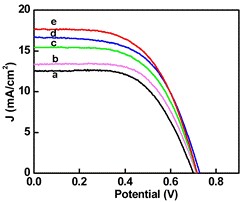The global energy crisis and environmental pollution have forced us to develop renewable, highly efficient methods of converting and storing energy without damaging the environment. Dye-sensitized solar cells (DSSCs) have been demonstrated as effective photovoltaic devices for low-cost and large-scale solar energy conversion applications. High-performance DSSCs require photoanodes with high surface area for sufficient dye anchoring and light-harvest capabilities. In this regard, hollow micro- or nanostructures with large surface areas, such as ZnO and TiO2 hollow microspheres, have been demonstrated as effective photoanodes.
The research team led by Prof. Dan WANG at Institute of Process Engineering (IPE) of the Chinese Academy of Sciences had developed a novel strategy to prepare multi-shelled hollow microspheres of transition metal oxides via programmable heating of sacrificial carbon sphere templates. By varying synthetic parameters, they had previously demonstrated control over the number of internal multi-shells and shell spacing for a variety of metal oxide multi-shelled hollow microspheres. (Angew. Chem. Int. Ed. 2011, 50, 2738-2741; Adv. Mater. 2012, 24, 1046-1049; Angew. Chem. Int. Ed. 2013, 52, 6417-6420)
Recently, they further modify their strategy by using alkali-treated carbonaceous microspheres (ATCMSs) as the templates to fabricate unique quintuple-shelled SnO2 hollow microspheres with closed exterior double shells (5S-SnO2-HMSs-CDS). DSSCs assembled with 5S-SnO2-HMSs-CDS photoanodes exhibit a new record conversion efficiency of 7.18% after TiCl4 treatment. The unique exterior double-shell of the hollow spheres enhances their light scattering and reflecting capabilities, and is the most influential factor that contributes to improvements in the short circuit current and photoconversion efficiency. Furthermore, photoanodes fabricated using 5S-SnO2-HMSs-CDS scattering layers on top of P25 films resulted in photoconversion efficiencies of up to 9.53%, a 30.7% increase in conversion efficiency when compared to P25 photoanodes without a scattering layer. The excellent light-scattering properties of 5S-SnO2 -HMSs-CDS make it a promising candidate as a photoanode or scattering material for DSSCs. This work opens up new opportunities for fabricating high-performance DSSCs based on structural design and manipulation of the hollow microspheres.
The results have been published on Adv. Mater.2014, 26, 905-909


(A) (B)
Figure 1. (A) Schematic illustration of the formation process of 5S-SnO2-HMSs-CDS;
(B) J-V curves of DSSCs based on SnO2 hollow spheres of: a) single shell, b) double shells, c) triple shells, d) quadruple shells, e) quintuple shells.(Image by IPE)
 Search
Search




 京公网安备110402500047号
京公网安备110402500047号